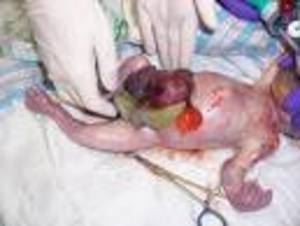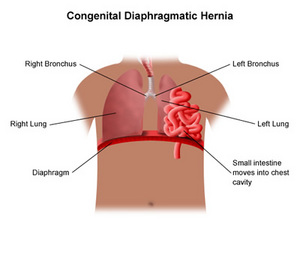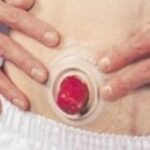Gastroschisis refers to babies born with organs outside the body. Gastroschisis is one of the most frequently encountered congenital anomalies in pediatric surgery. This condition happens about 1 in every 2,000 births. Gastroschsis is a defect or hole in the abdominal wall that lets the abdominal contents protrude outside the body. There is no peritoneal covering over the intestines and other organs. The hole is usually very small, but the exposed contents can range from the stomach to the rectum (almost all of the large and small intestine and stomach can be involved).
The abnormality can be seen by ultra sound as early as 14 weeks of pregnancy. Most often (75% of the time) it occurs with the first born baby. The malformation is always obvious at birth. It is a very frightening experience for new parents, but, in most cases, the defect can be totally repaired and the baby will completely recover.
Since the bowel is not contained inside the body, before birth, it floats freely in the amniotic fluid. Contact with the amniotic fluid can cause severe damage. The bowel can fail to grow, become thickened, matted, or shortened with poor mucosal function. The damage becomes more severe with prolonged exposure to the amniotic fluid, especially after thirty-five weeks gestation, so some physicians suggest early Cesarean delivery to limit bowel damage. Sometimes the physician performs weekly ultrasounds from thirty weeks on to watch for bowel wall thickening and when thickening is observed he delivers the baby by Cesarean delivery to limit bowel damage. There are many studies that claim there are no significant benefits of early Cesarean delivery over vaginal delivery at term.
Immediately after birth, any organs outside the baby’s body are covered with warm, moist sterile bandages and then placed inside a special plastic pouch. A nasogastric (NG) tube is placed in the baby’s nose or mouth to keep the stomach empty and to prevent chocking on or breathing in any stomach contents.
As soon as the infant is stable, surgery is done to put the intestines and organs back into the body. The surgeon examines the intestines to make sure there is no damage and that the edges of the intestines are sealed. The organs are placed back into the abdomen through the defective opening and the opening is repaired. Sometimes all the contents cannot fit back into the abdomen with the first surgery. The remaining intestines are put in the plastic pouch and are slowly pushed back into the abdomen over a period of time. Additional surgeries may be needed to repair the abdominal muscles at a later time.
Because the baby’s abdomen may be smaller than normal, placing the intestine in the abdomen increases the pressure within the area and may cause breathing difficulties. The baby may need to be placed on a ventilator to breathe for him for a few days or weeks. The baby will be given IV fluids, antibiotics, pain medication and oxygen. An NG tube will be used to keep the stomach empty until the intestines start to work normally and then normal feeding are very slowly started.
In most instances gastroschisis can be totally corrected with surgery.








